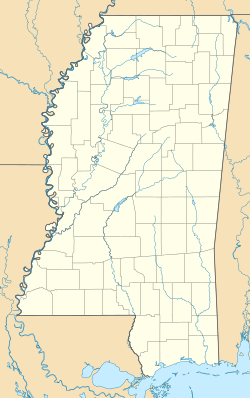Wechsler School facts for kids
|
Wechsler School
|
|

Unrestored section of Wechsler School
|
|
| Location | Meridian, Mississippi |
|---|---|
| Built | 1894 |
| Architect | Multiple |
| Architectural style | Italianate |
| NRHP reference No. | 91000880 |
Quick facts for kids Significant dates |
|
| Added to NRHP | July 15, 1991 |
Wechsler School is a special historic building in Meridian, Mississippi. It was built way back in 1894. This school was the very first brick public school in Mississippi. It was built with public money specifically for African-American children.
The school first taught students from first to eighth grade. Later, it grew to include high school classes too. It was named after Rabbi Judah Wechsler. He was a leader from Congregation Beth Israel. Rabbi Wechsler helped convince the people of Meridian to raise money to build the school.
Wechsler School is recognized as an important historical site. It was added to the National Register of Historic Places in 1991. It was also named a Mississippi Landmark in 1993.
Contents
History of Wechsler School
Building the First School in 1894
Public schools in Meridian started because of the 1870 Mississippi Constitution. From 1870 to 1885, a group called the Board of School Directors ran the schools. The first public school for African Americans in the city was held in a church building.
In 1888, the city was allowed to have its own school district. Soon after, $30,000 was approved to build new public schools.
By 1894, when Wechsler School was built, many children in the city were African American. Because of this, $15,000 was used to buy the land for the new school. The school was named after Rabbi Judah Wechsler. He had helped get people excited about building the school.
Wechsler School became the first brick public school in Mississippi built with public money for African Americans. Another school, Union School in Natchez, Mississippi, was built earlier in 1872. But Wechsler was the first one funded by the public.
The first building was a two-story structure. It had six rooms on the first floor. The second floor had two rooms and a large hall. The building had a fancy style called Italianate. It had tall, flat columns called pilasters on its sides. The main door had a curved roof over it.
The school was first heated by coal fireplaces. A small building nearby held the coal. In 1914, the school got new steam heating. This meant the coal house was no longer needed.
How the School Grew and Changed
In 1914, more money was approved for school improvements. About $75,000 helped add new parts to all city schools. Wechsler School built a brick addition south of the original building. This was to fit more students.
The new addition also had two stories. The second floor was connected to the old building by a walkway. Classrooms were on both floors of the addition. A room for the heating system was in the basement.
Wechsler School first taught grades one through eight. By 1921, it had all twelve grades. Ninth and tenth grades were added in 1915-16. Eleventh grade came in 1919-1920. The twelfth grade was added in 1921-22. Six students graduated that spring.
Wechsler School was the first public school in its area to offer high school diplomas to black students. It was the only one until 1937. That year, the high school program moved to the new T.J. Harris High School.
In the 1920s, the outside of the 1894 building was covered with a material called stucco. Inside, the first floor was changed. It got an office, four classrooms, and restrooms. The floors were covered with linoleum. The second floor had five classrooms, office space, a library, and more restrooms.
In 1922, the school started classes for adults. A teacher training program also moved to the school. This helped teachers get new licenses. In 1929, fifty teachers finished their training at Wechsler. The most students to graduate from Wechsler was eighty-seven in the 1935-36 school year.
Wechsler School's Later Years
The high school grades (9-12) moved to T.J. Harris High School in 1937. After that, Wechsler taught elementary and junior high students. It continued until 1971.
Another building was added to the school in 1951. This new part had four classrooms, a hall, a stage, and a cafeteria. It also had rooms for teachers and showers. A staircase connected the old building to the new one. The basement of the 1914 addition was also turned into classrooms. The heating system moved to the new 1951 building.
From 1971 to 1983, Wechsler School was used as a kindergarten. It taught both black and white children. But it closed down after the 1983 school year.
After closing as a school, a theater group used the building until 1986. Then it was empty for four years. In 1990, people in the community formed the Wechsler Community Art Center. The school was listed on the National Register of Historic Places in 1991. It became a Mississippi Landmark in 1993.
In 1994, the school board gave the building to the Art Center group. This group has been raising money to fix up the building. They want to use it as an art center and for other community events. They held dances and parties for teens to raise money. In 2000, they received money from the state. This money helped to make the building safe and ready for new uses. There is also a recent idea to turn the building into a charter school.
Former Principals
The Wechsler School had many principals over the years. Even before the building was finished in 1894, the first principal was chosen. They helped plan the school. Here are some of the principals:
- E.H. Triplett (1888–1896)
- O.C. Garrett (1896–1902)
- William Hopkins (1902–1916)
- R.S. Groosley (1916–1918)
- Thomas J. Harris (1918–1937)
- Lydia Carr (1937–1945)
- Jennie Ruth Crump (1945–????)



